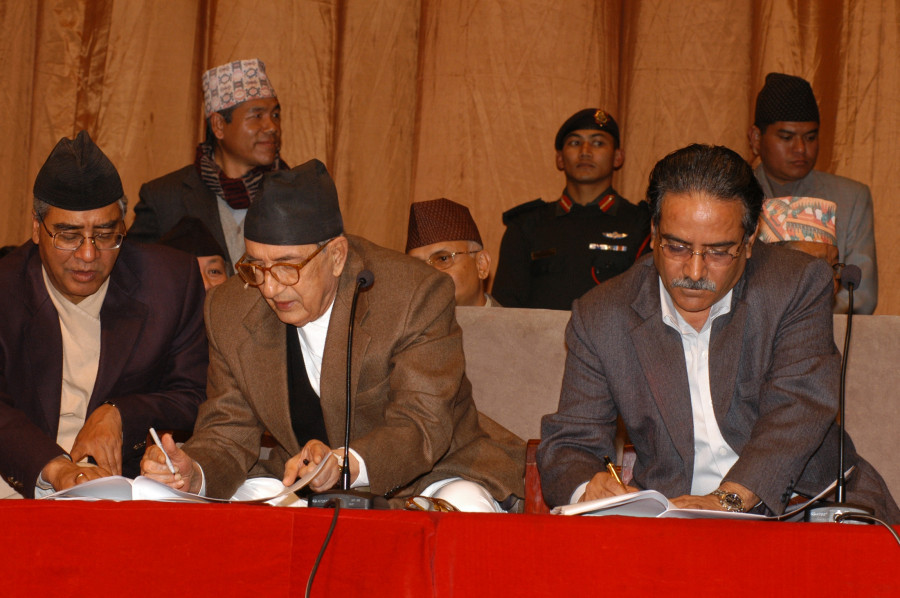Columns
Nepal's peace dilemma
The failure to conclude the transitional justice process undercuts the achievements in the structural transformation of Nepal.
Khim Lal Devkota
On November 21, 2006, the Comprehensive Peace Accord (CPA) was signed between the Government of Nepal (GoN) and the then Communist Party of Nepal (Maoist), officially bringing an end to the decade-long armed conflict. This document facilitated Nepal’s transition from war to peace, ending the Maoist insurgency that had started a decade earlier. As per the Nepal Conflict Report published by the United Nations Office of the High Commissioner for Human Rights in 2012, over 13,000 persons were killed in the insurgency, 1,300 went missing, and numerous others were displaced, mutilated, tortured and sexually exploited.
Path to peace
The CPA included various provisions aimed at promoting stability and reconciliation in the post-conflict period. Both sides were required to make public the status of the people in their custody and release them within 15 days. Additionally, they were obligated to disclose, within 60 days, information about the real name, caste and address of individuals who were 'disappeared' or killed during the war and inform their families. The agreement also mandated the formation of a 'National Peace and Rehabilitation Commission' to establish peace in society by normalising adverse situations generated by armed conflict, providing relief and rehabilitation for people victimised and displaced by war, and carrying forward related tasks through the commission. Furthermore, it was agreed to establish a Truth and Reconciliation Commission to investigate the truth about individuals seriously violating human rights and involved in crimes against humanity, creating an environment of reconciliation in society.
Article 33 of the Interim Constitution, 2007 addressed the CPA and contained mandates for relief, recognition, and rehabilitation for families of the deceased and individuals disabled during the armed conflict. It required providing relief to victims' families based on the report of the Investigation Commission, which will investigate cases of enforced disappearance during the conflict. The constitution emphasised the need for special programs to rehabilitate displaced persons, offer compensation for damaged property, and rebuild infrastructure. Additionally, it called for the establishment of a high-level 'Truth and Reconciliation Commission' to investigate individuals involved in serious violations of human rights and crimes against humanity during the conflict to foster an atmosphere of reconciliation in society.
Accordingly, the Government of Nepal submitted the Bill on Disappearances Act, 2066, and the Bill on Forming the Truth and Reconciliation Commission Act, 2066, to the legislature-parliament of the then Constituent Assembly. However, after the dissolution of the Constituent Assembly, those bills automatically became inactive.
Seeking truth
It is crucial to acknowledge the intricacies involved in drafting the constitution by the then Constituent Assembly. The political parties faced challenges in reaching a consensus, particularly on the restructuring of the state. The peace agreement also underscored the importance of addressing state restructuring. During that period, the integration of Maoist fighters into the Nepal Army was also a significant issue. With considerable effort, 1,460 out of the 19,600 Maoist fighters were successfully integrated into the Nepal Army. This accomplishment marked a significant milestone in the peace process deal.
The Enforced Disappearances Inquiry, Truth and Reconciliation Commission Act, 2071 (“TRC Act 2014”) was promulgated in May 2014. Subsequently, two separate commissions, namely the Truth and Reconciliation Commission (TRC) and the Commission of Investigation on Enforced Disappeared Persons (CIEDP), were established in February 2015. The commissions did some work: A total of 3,288 complaints have been registered, with 2,543 currently awaiting investigation. Moreover, 3,993 family members of 1,321 disappeared persons have received victim identification cards. The CIEDP has recommended that the government provide relief to the families of 551 missing persons who have not yet received assistance.
As for the TRC, 63,718 complaints have been registered, covering issues such as physical and mental torture, property damage, murder, displacement, injury, kidnapping, rape and sexual violence. Only about 4,000 complaints have undergone preliminary investigation. Due to the Supreme Court's verdicts, disputes among political parties, and repeated time extensions, the commissions have struggled to function effectively and have remained vacant since July 2022.
In numerous cases, the Supreme Court has ruled on issues such as the assertion that pardons cannot be granted in serious crimes without the consent of the victim, highlighting various serious human rights violations. It has also emphasised that the existing law is not victim-friendly. The court has said cases from the conflict era should not be prolonged any further. As the peace process unfolds, the international community is closely monitoring Nepal’s transitional justice. Further, many human rights activists have also suggested that the four pillars of transitional justice—truth, justice, reparation, and the guarantee of non-recurrence of conflict, as identified by the United Nations, should be considered a foundation.
Based on the court's verdicts, among others, the government registered a bill to amend the TRC Act 2014 in the Parliament Secretariat in March 2023. The bill is under discussion in the Law, Justice, and Human Rights Committee committee of the House of Representatives. Despite a sub-panel's attempt to streamline amendments and find common ground, it submitted an incomplete report in October 2023 due to a lack of consensus. Lawmakers couldn't agree on categorising killings, leading to ongoing debate. Conflict victims advocate for labelling various types of killings as serious human rights violations, including extrajudicial and unlawful acts. The committee remains undecided on the course of action if victims reject reconciliation.
Justice delayed
Among the four pillars of the peace process, the integration of Maoist combatants into the Nepal Army, state restructuring, and the promulgation of a new constitution have been accomplished. However, transitional justice has remained unresolved for the past 17 years. All parties involved in the conflict must acknowledge the truth regarding the violations committed. Undoubtedly, the victims and their families have the right to voice their concerns and receive appropriate answers to their questions. Seventeen years since the CPA, the task of investigating human rights violations since 1996, revealing the truth, disseminating the reality, delivering justice and assistance to victims, and fostering social reconciliation and enduring peace remains unfulfilled.
The peace process has yet to reach a logical conclusion, presenting a significant challenge. Nevertheless, notable changes have occurred: The previously centralised governance system has been constitutionally decentralised, integrating backward and marginalised communities such as women, Dalits, Madhesi, and Muslims into the mainstream; political stability has been achieved, demonstrated by two consecutive elections and the restructuring of the governance system; the empowerment of people and the assertion of their sovereign rights are evident, accompanied by the effective distribution of fiscal and human resources to their doorsteps.
It is crucial to interpret these positive developments in connection with the CPA. However, political parties must be sincere in bringing the peace process to a logical conclusion. It should not be perceived as a means of seizing power but rather as a pathway toward genuine resolution.




 16.12°C Kathmandu
16.12°C Kathmandu















